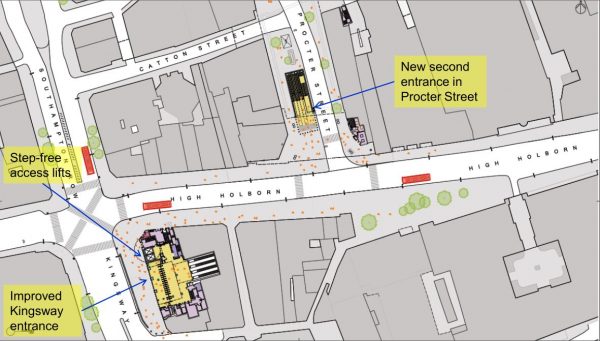A consultation held to show off plans to substantially upgrade Holborn tube station has found, unsurprisingly, widespread support for the plans. TfL can now move onto the next stage which is to flesh out the plans ahead of the second consultation in 2020 before seeking planning permissions.
The intention is to build a brand new entrance on the north side of High Holborn to relieve congestion on the existing Kingsway entrance, while also improving access to the Piccadilly line platforms.
If approved, work on the upgrade should start in 2023, and take around 6 years to complete. That deadline appears to have slipped by a couple of years, as the consultation indicated construction work would be starting in 2021.
Of the 981 public replies to the consultation, 86 percent strongly agreed that Holborn station needed upgrading, while 12 percent agreed in general — and 1 percent indicated that it’s perfectly fine as it is.
Presumably the one-percent use the station at very quiet times.
Responding to feedback that the upgrade should be delivered quicker, TfL noted that station capacity upgrade projects of this scale typically take around ten years to deliver. This includes around three to four years to secure the necessary planning permissions, including a Transport and Works Act Order, and a further five to six years to construct. Holborn is no different to stations such as Tottenham Court Road and Bond Street that have only just been completed.
There were also concerns about the construction, as the existing Kingsway entrance will have to close for 18-months during construction. However that wouldn’t happen until the new second entrance planned at Procter Street has opened.
One aspect of the upgrade plans that has caused concern, mainly with the heritage fans is that the link with the tunnels down to Aldwych station would need to be cut off forever, while the disused Platform 5 will be turned into a lower level concourse area.
TfL says that re-using the disused Platform 5 provides both a significant cost saving to the project and a considerable environmental benefit by reducing the extent of tunnelling works required.
They believe this benefit outweighs retaining train access to Aldwych station as there are no plans to re-open this branch line. However, the Aldwych station will retain its current use for filming and training.
There’s also a note in the documents that platform edge doors could be added later as part of the Piccadilly line upgrade to provide fully automated operation (known as GOA4) which, subject to funding, could be delivered by the mid 2030s.









When considering whether 10 years is a long time to upgrade Holborn, consider that the Central line was built in 9 years and the Piccadilly line 4 years, including building this station. The rebuild of Holborn in the 1930s to replace the lifts with escalators and build a Central line station, including tunneling around the operational line, took 2-3 years to complete.
I would suggest we have lost our way if we think that with modern technology, it is acceptable to take 3 times longer than in took in the 1930s to upgrade a station.
The main differences are:
– utility works: the number of cables and various piping increased dramatically since the 1930s, so it is much more difficult and takes much longer to divert them
– safety: our forefathers weren’t as concerned about safety of workers or stability of buildings above, as we are
– tunnelling around active station is way more difficult than around active train tunnels
– penny pinching: thanks to TfL budget cuts they have to spread-out upgrade spending over longer periods of time
“….platform edge doors could be added later as part of the the Piccadilly line upgrade….”
Excellent and overdue
A long-awaited upgrade and re-working of the site’s assets. Unfortunately, as you say, it chops off the link to Aldwych. It’s never a good idea to permanently remove options for the future and the only reason is surely to save money. How much to leave the branch platform in place, I wonder?
Why does it permanently remove options for the future? You can always dig a new platform for the branch, or dig new passageways and put the platform back in again. If you ever wanted to reinstate the branch, you would would want to change the junction layout at Holborn (it was always a mess), so there would have to be works at Holborn anyway. You would also have to rebuild Aldwych station to meet modern safety standards, would be significantly more expensive than works at Holborn.
I stand corrected, I think. I just assumed that it would be cheaper to carve out new access passages and then dust the cobwebs away from platform 5 if and when it is recommissioned, than chop out a whole new platform. I take your point about the awkward junction though.
Interesting.
Interesting indeed, esp as it becomes my closest station for work soon – no doubt in time for it to close for the works! As an aside, the problems of fitting lifts in to TfL stns is intriguing – lots of shafts and boring below ground, whilst above ground it usually means long bridges. Because most stns were built with stairs or escalator access, so the platforms are seldom aligned vertically with the street level entrance.
Aldwych could be reinstated as part of a new branch line or even a new line but it would need escalators which means you might as well just rill it in with concrete if it becomes unstable